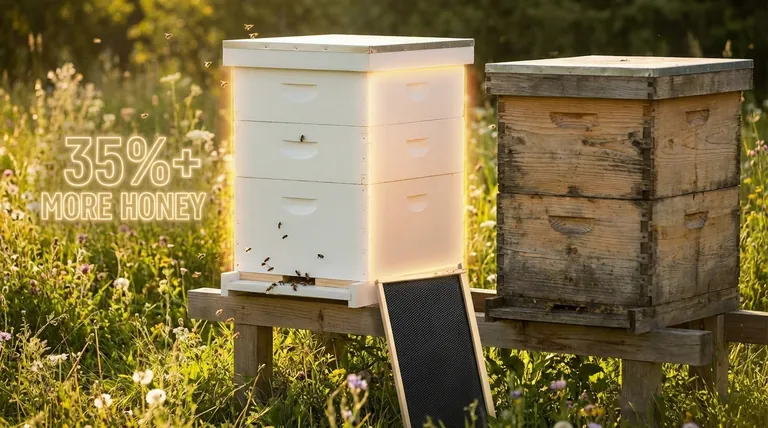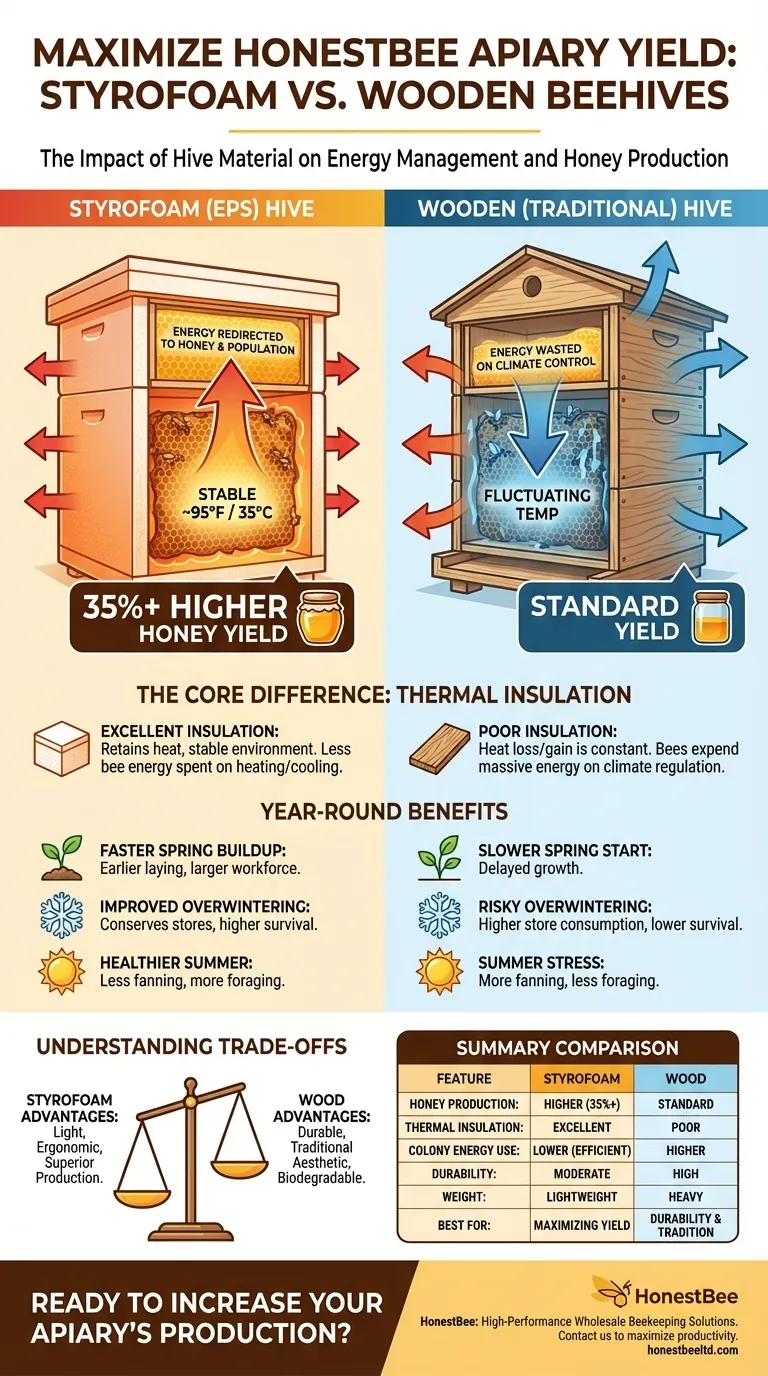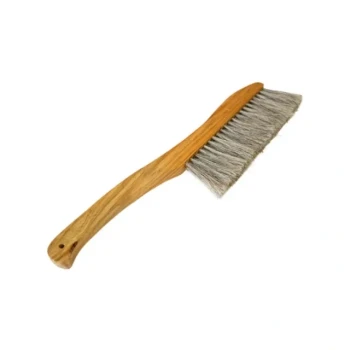From a purely production standpoint, the data is conclusive. Beehives made from high-density expanded polystyrene (EPS), or styrofoam, consistently produce more honey than traditional wooden hives. Studies and field reports show that beekeepers can see yield increases of 35% or more by using styrofoam equipment. This significant difference is not a matter of bee preference but a direct result of the hive's thermal efficiency.
The choice between styrofoam and wood is not just about material preference; it's a strategic decision about energy management. Styrofoam's superior insulation creates a more stable internal environment, allowing the bee colony to redirect energy from temperature regulation directly into population growth and honey production.

The Core Difference: Thermal Insulation
The primary driver behind the performance gap between styrofoam and wood is insulation. Bees must maintain a stable temperature in their brood nest (around 95°F or 35°C) to raise young, regardless of the outside weather.
How Insulation Impacts Colony Energy
In a wooden hive, the colony expends a tremendous amount of energy—and the honey they consume as fuel—to generate heat in the winter and to cool the hive in the summer. Wood is a relatively poor insulator, so this energy is constantly lost to the environment.
This constant energy expenditure for climate control directly reduces the resources available for other vital tasks, namely foraging for nectar and producing surplus honey.
The Styrofoam Advantage
Styrofoam is an exceptional insulator, drastically reducing heat transfer between the inside of the hive and the outside world.
This thermal stability means the colony uses far less energy to maintain its ideal internal temperature. The conserved energy is then reallocated to activities that benefit the beekeeper: raising more brood, building a larger workforce, and storing a larger honey surplus.
The Year-Round Impact on Colony Health
The benefits of superior insulation extend across all seasons, creating a stronger, more productive colony year-round.
Faster Spring Buildup
A warmer hive in the cool spring months encourages the queen to begin laying eggs earlier and more prolifically. This results in a larger population of forager bees just as the main spring nectar flows begin, allowing the colony to capitalize on early resources.
Improved Overwintering Success
In winter, insulation is critical. A styrofoam hive helps the colony conserve its winter honey stores and protects it from extreme cold snaps. This leads to higher survival rates and a much stronger colony emerging in the spring, ready for immediate growth.
Healthier Summer Conditions
Insulation also works to keep the hive cooler during intense summer heat. This reduces the colony's need to perform "bearding" (clustering on the outside of the hive) and fanning for ventilation, freeing up more bees to continue foraging during peak daylight hours.
Understanding the Trade-offs
While styrofoam offers clear advantages for production and colony health, it is not without its drawbacks. The choice is a matter of balancing priorities.
Durability and Lifespan
Wooden hives are exceptionally durable and, if properly maintained, can last for decades. They withstand rough handling and are less prone to damage from hive tools.
Styrofoam is a softer material. It can be easily gouged by hive tools or damaged by pests like wax moths or mice if the hive is not strong. It also requires painting to protect it from UV degradation over time.
Weight and Portability
Styrofoam hives are significantly lighter than their wooden counterparts. A full honey super made of styrofoam is much easier to lift than one made of wood, a major ergonomic benefit that reduces physical strain on the beekeeper.
Environmental and Aesthetic Considerations
Many beekeepers prefer the traditional look and feel of wood, viewing it as a more natural material. Wood is also biodegradable.
Styrofoam is a petroleum-based plastic. While modern, high-density hive bodies are durable and long-lasting, concerns about their environmental footprint and end-of-life disposal are valid considerations for some keepers.
Making the Right Choice for Your Operation
Your ideal hive material depends on your specific goals as a beekeeper.
- If your primary focus is maximizing honey yield and colony growth: Styrofoam is the clear winner due to its superior insulation and the direct impact on colony energy management.
- If your primary focus is long-term durability and a traditional aesthetic: A well-maintained wooden hive remains a reliable and time-tested choice that can serve you for many years.
- If your primary focus is ease of handling and physical management: The lightweight nature of styrofoam provides a significant ergonomic advantage, especially for beekeepers with physical limitations or large operations.
By understanding that hive material is fundamentally a tool for managing colony energy, you can select the equipment that best aligns with your beekeeping goals.
Summary Table:
| Feature | Styrofoam Hive | Wooden Hive |
|---|---|---|
| Honey Production | Higher (35%+ increase) | Standard |
| Thermal Insulation | Excellent | Poor |
| Colony Energy Use | Lower (more efficient) | Higher |
| Durability | Moderate (can be damaged) | High (long-lasting) |
| Weight | Lightweight | Heavy |
| Best For | Maximizing yield, faster spring buildup | Durability, traditional aesthetics |
Ready to increase your apiary's honey production and improve overwintering success?
At HONESTBEE, we supply commercial apiaries and beekeeping equipment distributors with high-performance, wholesale-focused beekeeping solutions. Our high-density styrofoam beehives are engineered for superior thermal efficiency, helping your colonies direct more energy into honey production.
Contact our wholesale team today to discuss how our equipment can maximize the productivity and health of your operation.
Visual Guide

Related Products
- Food Grade Plastic bee Foundation for Bee Frames
- Professional Galvanized Hive Strap with Secure Locking Buckle for Beekeeping
- Mesh Ventilated 3 Layer Goatskin Beekeepers Gloves for Beekeeping
- High Performance Plastic Queen Excluder for Beekeeping and Apiary Management
- Endless Loop Ratchet Hive Strap
People Also Ask
- How do you get bees to draw out plastic foundation? Master the Art of Comb Building
- Why do commercial beekeepers prefer plastic foundation? Durable, Reusable, and Cost-Effective
- How does plastic foundation differ from beeswax foundation? Choose the Best for Your Hive's Success
- What additional step can improve the performance of plastic foundation in the hive? Apply a Generous Coat of Beeswax
- Does plastic foundation affect honey quality or taste? A Practical Guide for Beekeepers



















